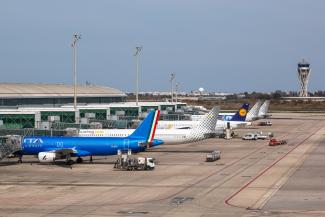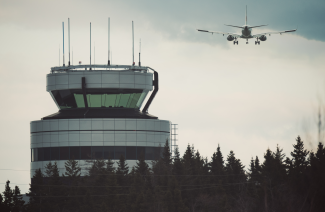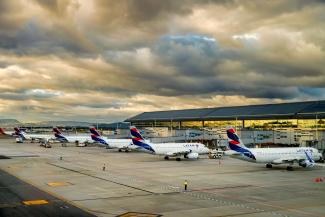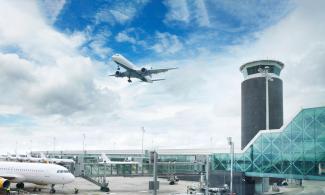The Dutch Government’s recently scrapped decision to reduce Amsterdam Schiphol’s capacity for 2024, from 500k to 450k operations per year, has once again spurred up the debate of sustainability in the aviation sector, particularly in Europe. Although finally dismissed, it was one of multiple initiatives that have been proposed by European governments with the goal of reducing carbon emissions and, in some cases, noise. In early 2023 the French Government signed a law banning short-haul domestic flights that have a 2.5h-or-less high-speed rail alternative, while the Spanish Government proposed a similar plan as part of the country’s long-term sustainability initiative. In the UK, plans for London Heathrow’s third runway have been postponed many times mainly due to environmental reasons. And the list goes on.
Analysts say that these are the first of a series of laws and regulations that will begin to take shape in Europe in the near future, given the pressure that the aviation sector faces from an environmental point of view. So, how effective are these initiatives and what effect will they have on European connectivity? What alternatives does the aviation sector have?
It is no surprise that most laws that look to reduce flights have been received with criticism from the aviation sector. The industry has its own initiatives for sustainability, which involve the increased use of sustainable aviation fuel (SAF) and new propulsion technology (i.e. hydrogen and electricity) that is set to roll out in the mid-term. But environmentalists claim that these are not enough to reduce the carbon footprint of the industry, and thus have pushed, with increasing success, for governments to cut “unnecessary” flights in the short-term. We analyze the French and Spanish, the Dutch, and the British cases.

Headlines of various environment-related measures taken by European Governments in recent years
France and Spain, against short-haul unnecessary flights
France’s law banning short-haul domestic flights and Spain’s similar proposal look to transfer the domestic short-haul demand from air to rail. By doing this, Governments expect to reduce the number of unnecessary flights where there is a high-speed rail alternative. However, critics say that these are merely symbolic measures.
In France, the law, which bans short-haul domestic flights that have a rail alternative, has several exceptions that include flights that connect internationally, and those whose high-speed rail alternative does not have enough frequencies at specific times, among others. Narrowed down, only three French domestic routes were significantly affected by the ban: Paris Orly (ORY) to Bordeaux (BOD), Nantes (NTE), and Lyon (LYS). According to OAG, these represented only 0.04% of the domestic seats offered in France in 2022. The map of affected routes and the proportion of affected domestic capacity is shown below.

In France’s case, the Government proudly communicated that this new law came into effect, but analysts were quick to explain that the number of affected seats was close to insignificant. Nevertheless, it represents a step towards enacting laws that look to replace flight capacity with other means of transportation, such as electric high-speed trains.
The Spanish case is similar, and while still under discussion, it has led analysts to explore the effects it would have should it be in fact implemented. The ban on routes with a high-speed rail alternative of 2.5h or less would only strictly affect the Madrid-Valencia route, although flights from Madrid to Sevilla, Alicante, Malaga, and Barcelona could also be affected depending on the final proposal. Nevertheless, the proposal would supposedly not affect flights with international connecting passengers, which would drastically reduce the volume and number of routes affected.
An in-depth analysis recently performed by ALG explored the historic relationship between high-speed rail and air services between the main cities in Spain. In fact, the deployment of high-speed rail between Madrid and Barcelona (Spain’s largest cities) has organically reduced air traffic between the two points. The evolution of train/air share, as well as the decrease of air connectivity is shown below.

As shown above, as of 2021, over 70% of passengers in the Madrid-Barcelona route already traveled by train. This means that train connectivity has already naturally replaced air services on this route, reaching an equilibrium that gives a choice to passengers, with a reasonable number of seats offered in both modes of transportation, and allows a high degree of connecting passengers in Madrid (roughly half of the passengers that currently travel by air on this route are connecting passengers).
Limiting all O/D traffic on the route to train services, as the proposed law intends to, would only affect around 12 daily flights (out of 34) that given their departure/arrival times do not clearly cater to connecting traffic in Madrid (which does not mean it is inexistent), according to ALG’s estimate. This equates to roughly 30% of the air traffic on the route, although in reality it could be lower. The impact on other affected routes is expected to be much lower given that there are less flights on them, of which most have scheduled times adjusted for optimal connectivity.
In conclusion, the measure to further reduce air services between cities such as Madrid and Barcelona, or Madrid and Malaga, would force an evolution that has already been happening gradually through the years, and would have a moderate-to-low impact. An even lower impact is expected from France’s domestic air connectivity law, which has been branded as a rather symbolic move.
The Dutch case, potentially redistributing European traffic
The flight cap that was imposed on Amsterdam for 2024, and later dismissed, was supposed to have a significant impact given that, rather banning specific routes, it looked to reduce the number of flights that all airlines would be able to operate at the airport. It was a rather controversial move, particularly because it fully banned some airlines, such as the new JFK-AMS operator JetBlue, from flying to Amsterdam during the summer 2024 season. Additionally, it would have reduced the number of flights that the Dutch flag-carrier KLM would have been able to operate, along with its SkyTeam partner Delta, potentially harming the US-EU North-Atlantic connectivity. This led to a massive lobbying effort from stakeholders such as IATA or Airlines for America, and involved the US Department of Transportation and the European Commission, eventually forcing the Dutch Government, which was decided to enact the proposal, to scrap it.
The proposed cap was established at 450k ATMs, a 10% reduction vs. the 2018/2019 historic aircraft movements. This would limit the passenger capacity of the airport at around 63 Mpax, vs. the 71 Mpax recorded in 2019. The historic evolution of aircraft movements and the scrapped limit proposed for 2024 are shown below.

Historic evolution of aircraft movements at AMS vs. limit proposed by the Dutch Government (000’ ATMs)
While the proposal was dismissed, it did cause panic amongst airlines operating at AMS, which would have seen their 2024 operation at the airport either limited, or fully removed. The significance of this proposal comes from it being the first attempt to directly cut flights in one of Europe’s largest airports, and one which did have real possibilities of being enforced.
Nevertheless, an analysis performed by ALG concluded that, given Amsterdam Schiphol’s role as an intercontinental connecting hub (nearly 40% of the total traffic at AMS is connecting traffic), most of this traffic would not disappear nor find an alternative mode of transportation, but rather be redistributed among the remaining European hubs (MAD, FRA, CDG, LHR), which also have high shares of connecting traffic. This would result in a net reduction of half of the 50k ATMs that the proposal aimed to remove (O/D traffic).
As in other laws/proposals recently passed in Europe, the measure would do little to reduce overall air-transport-related emissions. Additionally, a 10% reduction on flights would likely not translate into a significant improvement in the quality of life of those affected by noise, yet the effect of reduced capacity in the price of airfares and the economic state of the airlines would be significant.
London Heathrow’s controversial third runway
London Heathrow (LHR), Europe’s busiest airport by passenger numbers, has historically been limited by its 2-runway airfield, which has restricted aircraft movements in the past 20 years. With over 79 Mpax recorded in 2023, the airport has little room to grow given its almost-fully-optimized airfield configuration, and the massive opposition it has faced to a proposed third runway construction.
The initial proposal to build a third runway, which would allow the airport to comfortably grow and accommodate an additional 260k ATMs per year, was made official in 2009. The proposal was scrapped and put back on the table several times thereafter, namely in 2013, 2015 and 2018, until, in 2020 it was dismissed given the Covid-19 crisis. The main reasons that the plan for the third runway has been so controversial include the noise complaints that the airport currently faces (in fact, the airport has a curfew between 22:50-06:00, which further limits operations), the existing buildings/areas that would have to be demolished for its construction, and the opposition of environmental activists.

Render of Heathrow’s proposed third runway (left on the image)
The airport reached its peak of operations in 2011, when it recorded just over 476k ATMs. Since then, given the curfews imposed, as well as the runway capacity, have led annual operations to remain roughly at 475-476k ATMs/year, with passenger growth being fueled by an increased average number of passengers per ATM. The ATM evolution of the airport between 2010 and 2023 is shown below.

Historic evolution of aircraft movements at LHR (000’ ATMs)
As it may be seen above, aircraft movements have remained relatively stable in the previous decade. On the other hand, passenger traffic has grown from 65.8 Mpax in 2010, to 70.2 in 2023, transitioning from an average 146 passengers per ATM in 2010, to 174 passengers per ATM in 2023.
Heathrow’s years of debate for a new runway have significantly restricted the airport’s growth, which has made it extremely difficult to obtain a landing slot at the airport. Nevertheless, this has not prevented flights to other London airports (namely LGW, STN, and LTN) to grow, and airlines to complement their LHR capacity at other airports. Traffic, in this case, has simply been distributed among the other airports, creating further inefficiencies from a decentralized airport system, and not solving in any way London’s emissions problem that environmental groups argue for. As of today, the third runway project remains on standby, with little hopes that it will go forward at some point in the future.
The future: effective solutions, not symbolic ones
Not all measures taken by European Governments in recent years have effectively approached the real environmental issues that the aviation industry faces. Many, as the ones described above, could be interpreted as symbolic measures taken by Governments to catch headlines, while everything remains as usual, and even in some cases worse, given the inefficiencies that these create. Some of these measures also tend to be the cheap and easy to implement by Governments, while their long-term effectiveness continues to be heavily questioned.
When designing aviation policy, and given the role that air transport plays in terms of economic and social development worldwide, Governments should consider ICAO’s three pillars for sustainability: social, economic, and environmental. Any policy that may hinder any of these pillars is a questionable policy. ICAO is committed to help reduce the environmental footprint of aviation, and, along with industry associations such as IATA, helps shape regulation to balance the aforementioned pillars.
In the past decades, global standards for aircraft efficiency and noise have tightened significantly, with new technological developments allowing cleaner aircraft to be delivered, while lowering airfares for passengers and promoting the economic sustainability of the sector. Most airlines are continually striving to reduce their environmental footprint by renewing their fleets, and airports are raising their noise standards for the benefit of their communities. Nevertheless, these standards should be raised to produce a real environmental, social, and economic impact, and not to fulfill a political agenda.
In the short and mid-terms, the aviation industry and its environmental footprint will benefit from the development of Sustainable Aviation Fuel (SAF) initiatives. These, while already tested, are yet to be industrialized in order to further reduce its cost for airlines (and therefore passengers); the challenge, therefore, to upscale the production of SAF-type fuels remains, and it is in the hands of Governments and international alliances to promote and finance this production. A coordinated approach between countries and aviation stakeholders regarding the production, distribution, and utilization of SAF-type fuels is required in order to approach this new technology and produce positive social, economic, and environmental results.
Further down the road, albeit not too far away, the industry will see new types of propulsion methods such as electric propulsion (for small and medium-sized aircraft) and hydrogen, which will drastically reduce the environmental footprint of air transport. Aviation OEMs, Governments, airports, and other stakeholders are preparing for these technologies, and while results are not immediate, and therefore may not fulfill immediate political goals, it is imperative that the right amount of financing mechanisms exist and that a degree of political will is there in order for them to be as efficient as possible.












































































